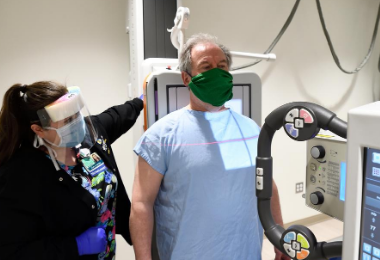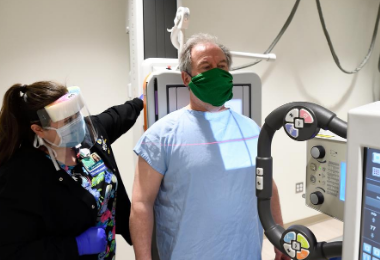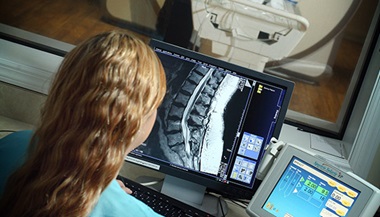Magnetic Resonance Imaging (MRI) of the Bones, Joints, and Soft Tissues
What is magnetic resonance imaging (MRI)?
Magnetic resonance imaging (MRI) is a diagnostic exam that uses a combination of a large magnet, radiofrequencies and a computer to produce detailed images of organs and structures within the body. MRI does not use ionizing radiation.
How does an MRI scan work?
The MRI machine is a large, cylindrical (tube-shaped) machine that creates a strong magnetic field around the patient and pulses of radio waves are sent from a scanner. The radio waves knock the nuclei of the atoms in your body out of their natural position. As the nuclei realign into proper position, they send out radio signals. These signals are received by a computer that analyzes and converts them to form a two-dimensional (2D) image of the part of the body being examined. This image then appears on a viewing monitor.
Some MRI machines look like narrow tunnels, while others are more spacious or wider. MRI scans can last from 30 minutes to two hours.
What are the reasons for an MRI of the bones, joints or soft tissues?
In orthopedics, an MRI may be used to examine bones, joints, and soft tissues such as cartilage, muscles, and tendons for injuries or the presence of structural abnormalities or certain other conditions, such as tumors, inflammatory disease, congenital abnormalities, osteonecrosis, bone marrow disease, and herniation or degeneration of discs of the spinal cord. MRI may be used to assess the results of corrective orthopedic procedures. Joint deterioration resulting from arthritis may be monitored by using magnetic resonance imaging.
There may be other reasons for your physician to recommend an MRI of the bones, joints, or soft tissue.
What are the risks of an MRI?
Because radiation is not used, there is no risk of exposure to ionizing radiation during an MRI procedure. Each patient must be screened before exposure to the MRI magnetic field.
Due to the use of the strong magnet, special precautions must be taken to perform an MRI on patients with certain implanted devices such as pacemakers or cochlear implants. The MRI technologist will need some information regarding the implanted decide, such as the make and model number, to determine if it is safe for you to have an MRI. Patients who have internal metal objects, such as surgical clips, plates, screws or wire mesh, might not be eligible for an MRI exam.
If there is a possibility that you are claustrophobic then you should ask your physician to provide you with anti-anxiety medication that you can take prior to your MRI examination. You should plan to have someone drive you home afterward.
If you are pregnant or suspect that you may be pregnant, you should notify your health care provider. To date, there is no information indicating that MRI is harmful to an unborn child, however, MRI testing during the first trimester is discouraged.
A doctor may order a contrast dye to be used during some MRI exams in order for the radiologist to better view internal tissues and blood vessels on the completed images.
If contrast is used, there is a risk for allergic reaction to the contrast. Patients who are allergic or sensitive to contrast dye or iodine should notify the radiologist or technologist.
If you have severe kidney disease or are on kidney dialysis, there is a risk of a condition called "nephrogenic systemic fibrosis" from the contrast dye. You should discuss this risk with your doctor prior to the test.
Nephrogenic Systemic Fibrosis (NSF) is a very rare but serious complication of MRI contrast use in patients with kidney disease or kidney failure. If you have a history of kidney disease, kidney failure, kidney transplant, liver disease or are on dialysis, you must inform the MRI technologist or radiologist prior to receiving contrast.
MRI contrast may have an effect on other conditions, such as allergies, asthma, anemia, hypotension (low blood pressure), kidney disease, and sickle cell disease.
There may be other risks depending on your specific medical condition. Be sure to discuss any concerns with your doctor prior to the procedure.
How do I prepare for an MRI?
EAT/DRINK: You may eat, drink and take medications as usual for most MRI exams. There are some specialty MRI exams that require certain restrictions. You will be provided detailed preparations instructions by Johns Hopkins Medical Imaging when you schedule your exam.
CLOTHING: You must completely change into a patient gown and lock up all personal belongings. A locker will be provided for you to use. Please remove all piercings and leave all jewelry and valuables at home.
WHAT TO EXPECT: Imaging takes place inside of a large tube-like structure, open on both ends. You must lie perfectly still for quality images. Due to the loud noise of the MRI machine, earplugs are required and will be provided.
ALLERGY: If you have had an allergic reaction to contrast that required medical treatment, contact your ordering physician to obtain the recommended prescription. You will likely take this by mouth 24, 12 and two hours prior to examination.
ANTI-ANXIETY MEDICATION: If you require anti-anxiety medication due to claustrophobia, contact your ordering physician for a prescription. Please note that you will need some else to drive you home.
STRONG MAGNETIC ENVIRONMENT: If you have metal within your body that was not disclosed prior to your appointment, your study may be delayed, rescheduled or canceled upon your arrival until further information can be obtained.
Based on your medical condition, your health care provider may require other specific preparation.
When you call to make an appointment, it is extremely important that you inform if any of the following apply to you:
-
You have a pacemaker or have had heart valves replaced
-
You have any type of implantable pumps, such as an insulin pump
-
You have vessel coils, filters, stents, or clips
-
You are pregnant or think you might be pregnant
-
You have any body piercing
-
You are wearing a medication patch
-
You have permanent eyeliner or tattoos
-
You have ever had a bullet wound
-
You have ever worked with metal (for example, a metal grinder or welder)
-
You have metallic fragments anywhere in the body
-
You are not able to lie down for 30 to 60 minutes.
What happens during an MRI?
MRI may be performed on an outpatient basis or as part of your stay in a hospital. Procedures may vary depending on your condition and your doctor's practices.
Generally, MRI follows this process:
-
You will be asked to remove any clothing, jewelry, eyeglasses, hearing aids, hairpins, removable dental work, or other objects that may interfere with the procedure.
-
If you are asked to remove clothing, you will be given a gown to wear.
-
If you are to have a procedure done with contrast, an intravenous (IV) line will be started in the hand or arm for injection of the contrast dye.
-
You will lie on a scan table that slides into a large circular opening of the scanning machine. Pillows and straps may be used to prevent movement during the procedure.
-
The technologist will be in another room where the scanner controls are located. However, you will be in constant sight of the technologist through a window. Speakers inside the scanner will enable the technologist to communicate with and hear you. You will have a call button so that you can let the technologist know if you have any problems during the procedure. The technologist will be watching you at all times and will be in constant communication.
-
You will be given earplugs or a headset to wear to help block out the noise from the scanner. Some headsets may provide music for you to listen to.
-
During the scanning process, a clicking noise will sound as the magnetic field is created and pulses of radio waves are sent from the scanner.
-
It will be important for you to remain very still during the examination, as any movement could cause distortion and affect the quality of the scan.
-
At intervals, you may be instructed to hold your breath or to not breathe, for a few seconds, depending on the body part being examined. You will then be told when you can breathe. You should not have to hold your breath for longer than a few seconds.
-
If contrast dye is used for your procedure, you may feel some effects when the dye is injected into the IV line. These effects include a flushing sensation or a feeling of coldness, a salty or metallic taste in the mouth, a brief headache, itching, or nausea and/or vomiting. These effects usually last for a few moments.
-
You should notify the technologist if you feel any breathing difficulties, sweating, numbness, or heart palpitations.
-
Once the scan is complete, the table will slide out of the scanner and you will be assisted off the table.
-
If an IV line was inserted for contrast administration, the line will be removed.
While the MRI procedure itself causes no pain, having to lie still for the length of the procedure might cause some discomfort or pain, particularly in the case of a recent injury or invasive procedure such as surgery. The technologist will use all possible comfort measures and complete the procedure as quickly as possible to minimize any discomfort or pain.
What happens after an MRI?
You should move slowly when getting up from the scanner table to avoid any dizziness or lightheadedness from lying flat for the length of the procedure.
If any sedatives were taken for the procedure, you may be required to rest until the sedatives have worn off. You will also need to avoid driving.
If contrast dye is used during your procedure, you may be monitored for a period of time for any side effects or reactions to the contrast dye, such as itching, swelling, rash, or difficulty breathing.
If you notice any pain, redness, and/or swelling at the IV site after you return home following your procedure, you should notify your physician as this could indicate an infection or another type of reaction.
Otherwise, there is no special type of care required after an MRI scan of the bones, joints, and soft tissues. You may resume your usual diet and activities unless your physician advises you differently.
Your physician may give you additional or alternate instructions after the procedure, depending on your particular situation.





